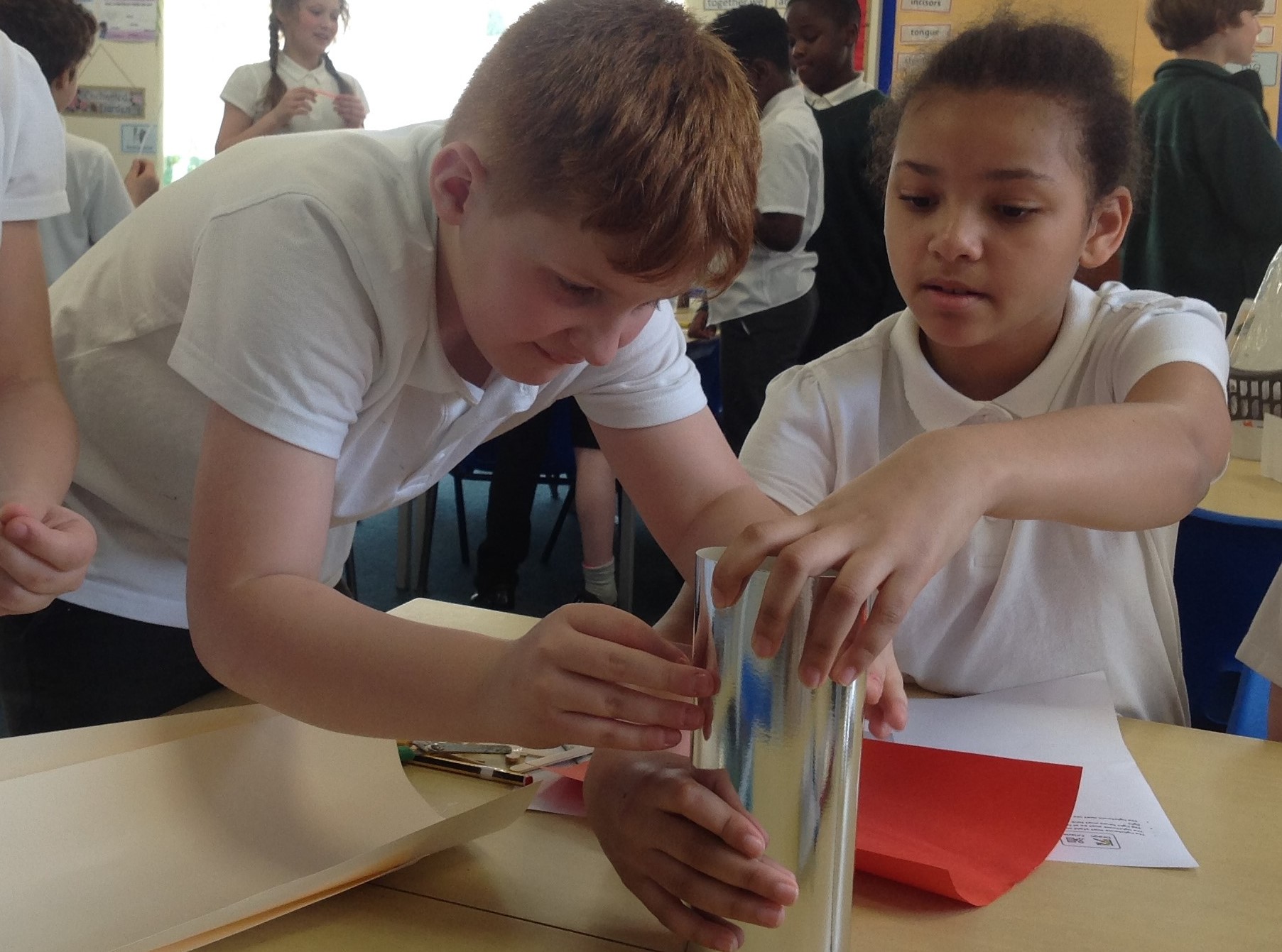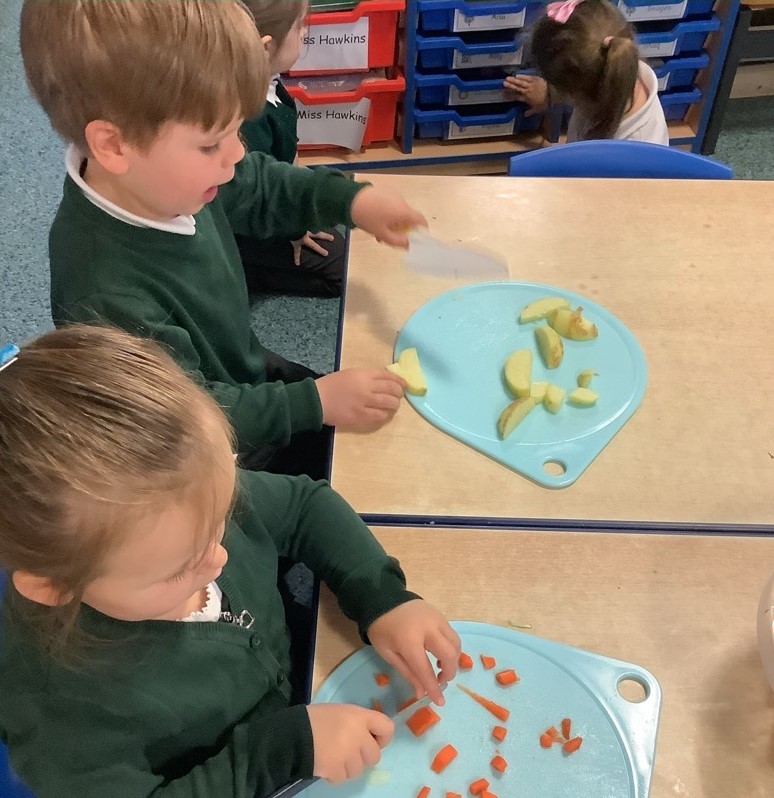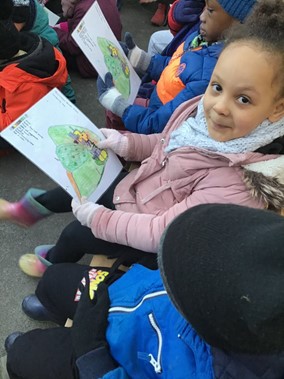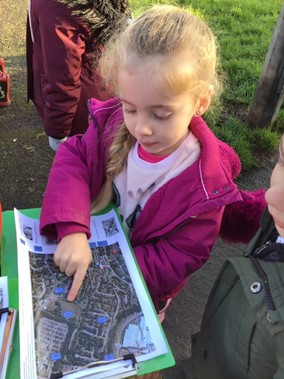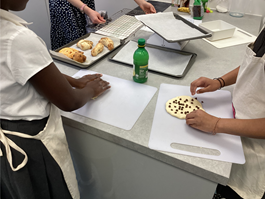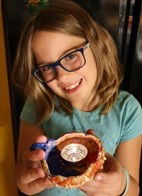Our Curriculum Intent
At Hollinswood Primary School and Nursery, we want to be Welders, Footballers, Performers, Teachers, Scientists, Vets, Vloggers, Astronauts, Archaeologists, Pilots, Hairdressers, Engineers and Fashion Designers. We want to be confident in our own abilities and feel like we’re a part of something bigger than us. We want to ask questions to expand our knowledge, becoming sociable learners and we want to use our experiences to take on greater adventures in life together, as a team. We need to remember that we can be perfect learners and we can achieve anything we put our minds to.
Written in conjunction with the School Council
At Hollinswood Primary our curriculum develops four key values of respect, resourcefulness, resilience and responsibility in our children.
|
Being respectful
|
|
|
Being resourceful
|
|
|
Being resilient
|
|
|
Being responsible
|
|
Find out more about how we teach and learn at Hollinswood in our Teaching and Learning policy
Our curriculum design
The curriculum at Hollinswood is driven by our school values.
· Being respectful
· Being resourceful
· Being resilient
· Being responsible
We aim for every child to leave our school with the knowledge, skills, values, and attitudes needed to be educated citizens and succeed in their next stage of education. To do this we plan a curriculum that is relevant, responsive, and ambitious, regardless of a child’s starting points.
Our curriculum has been designed to create a balance between the National Curriculum statutory requirements and a range of experiences which give our children the opportunities to broaden their life experiences.
Furthermore, our curriculum is designed to enrich their view on living in modern Britain and the world by exposing them to learning about a wide and diverse range of people, societies and places from past to present.
Knowledge
Teaching children knowledge is central to our curriculum. The more children know, the more they can play around with new ideas and make insights. Children who have lots of subject-specific knowledge find that new knowledge sticks to it, helping them commit the new information to long term memory.
We teach the children two different types of knowledge:
Disciplinary – the methods that establish the substantive facts, e.g. observation of the sun, moon and stars, satellite photographs.
Substantive – established facts, e.g. the earth is the planet on which we live.
Memory
When we teach something, the information goes first into the working memory and then, in the right conditions, it passes into the long-term memory. Once here, information can be retrieved back into the short-term memory. The working memory has very limited capacity and is easily overwhelmed. By contrast, the capacity of the long-term memory is vast. If we want children to remember stuff for the long term, we need to make the most of this huge capacity. The aim of all learning should be to improve long term learning.
Cognitive overload occurs when we overwhelm the limited working memory with too much new information at once. Since most of us can only handle about 4 new items of information at once, stuff will start to leak if we try and put too much in at once.
Schema-building
As our minds build knowledge, it forms into schemas or networks of knowledge and we integrate new material into our existing schemas. When we designed our curriculum, we thought carefully about the content that would be taught and the order in which we teach it, in order to give our pupils, the best chance of building it into secure, robust schemas which will form the foundation of what they will go onto learn in the future.
Key Threads to Support Personal Development and British Values Across the Curriculum
Our curriculum is designed around key ideas, golden threads and themes that run throughout and across the curriculum, which are:
- Heritage
- Diversity
- Community and belonging
- Sustainability
These themes and ideas are embedded across the curriculum and directly plug children in to understanding the world around them. They further deepen children’s understanding of the school values: responsibility, resourcefulness, resilience and respectfulness.
We want our pupils to form attachment with their school and wider community. Our heritage curriculum encourages our pupils, who come from around the world or from part of what is a relatively new estate, to feel a sense of understanding and belonging to their community from past to present.
Furthermore, Hollinswood is a diverse community, as is Telford; therefore, we encourage and celebrate the multi-cultural nature of our school- readying them for life in modern Britain and addressing specific misconceptions they may have about migration and immigration from the past to the current day. This also encourages pupils to develop mutual respect, understand laws, protected characteristics and ideas around democracy.
Sustainability is a key idea in our curriculum too and as the climate and the world around them changes, we want to encourage pupils to recognise their role in the world and encourage them to be pro-active in dealing with problems, understanding change and their place in the world.
The main principles of our curriculum design are:
· Knowledge content is specified in detail.
· Knowledge is taught to be remembered not merely encountered.
· Knowledge is thoughtfully selected, intelligently sequenced, and carefully secured.
· Concepts are used to support schema-building.
At Hollinswood Primary School and Nursery, children are assessed during every lesson which enables our teachers to plan the next steps for each child. Teachers assess against the learning objectives, then provide ongoing feedback which enables each pupil to make progress within the lesson and over time. Children are expected to make good or better progress in all subjects.
Subject Leaders build a picture of their subject over time. This picture-building may include capturing pupil voice, capturing staff voice, book looks, lesson drop-ins, planning reviews and evaluating assessment overviews at the end of units. Subject Leaders feedback on their subject to Senior Leaders termly and actions are identified for further development.
Click here: for the whole school overview.
Click here for our Personal Development Road Map which details the opportunities and experiences that the children will encounter during their time at Hollinswood Primary School & Nursery.
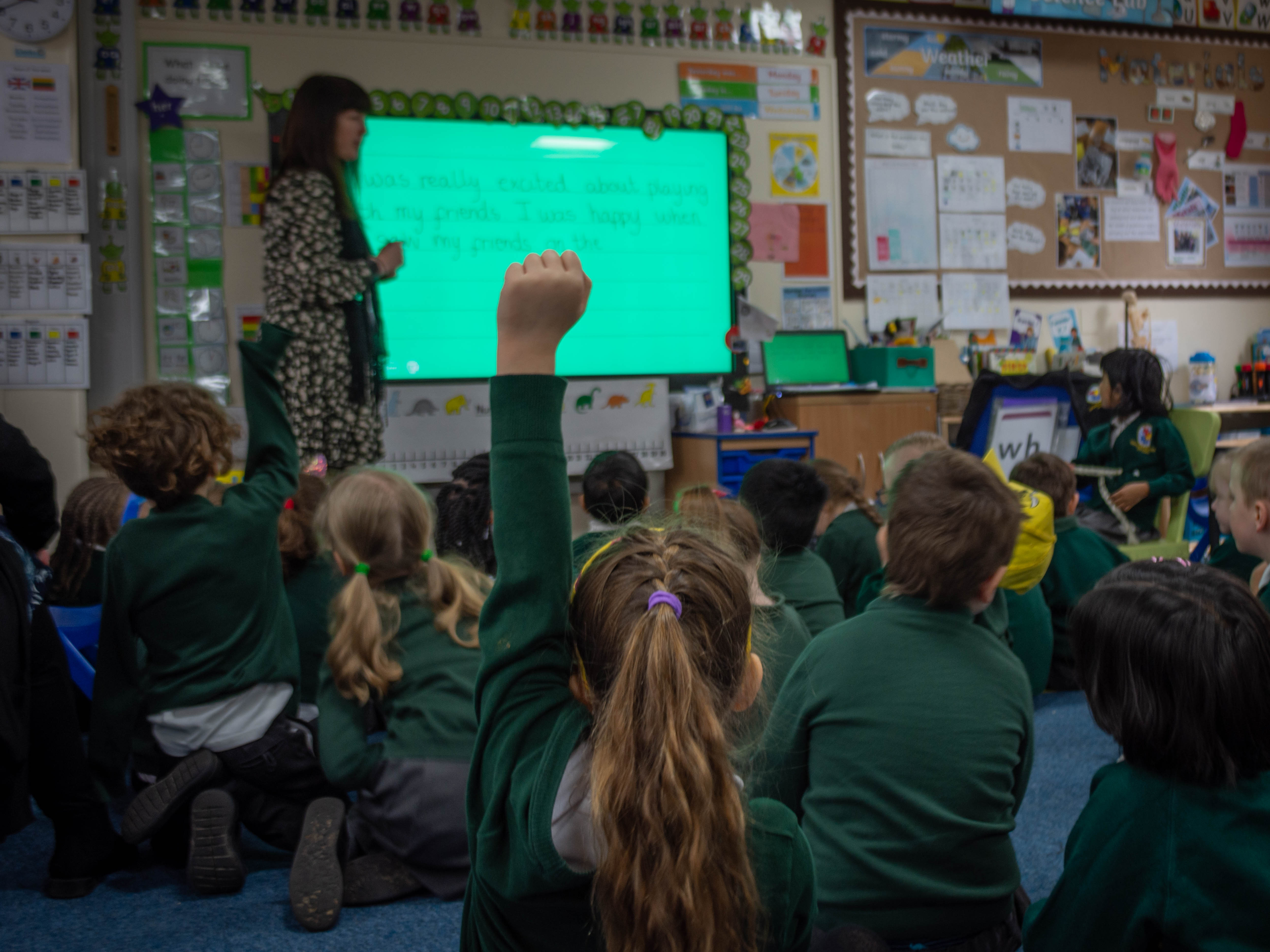
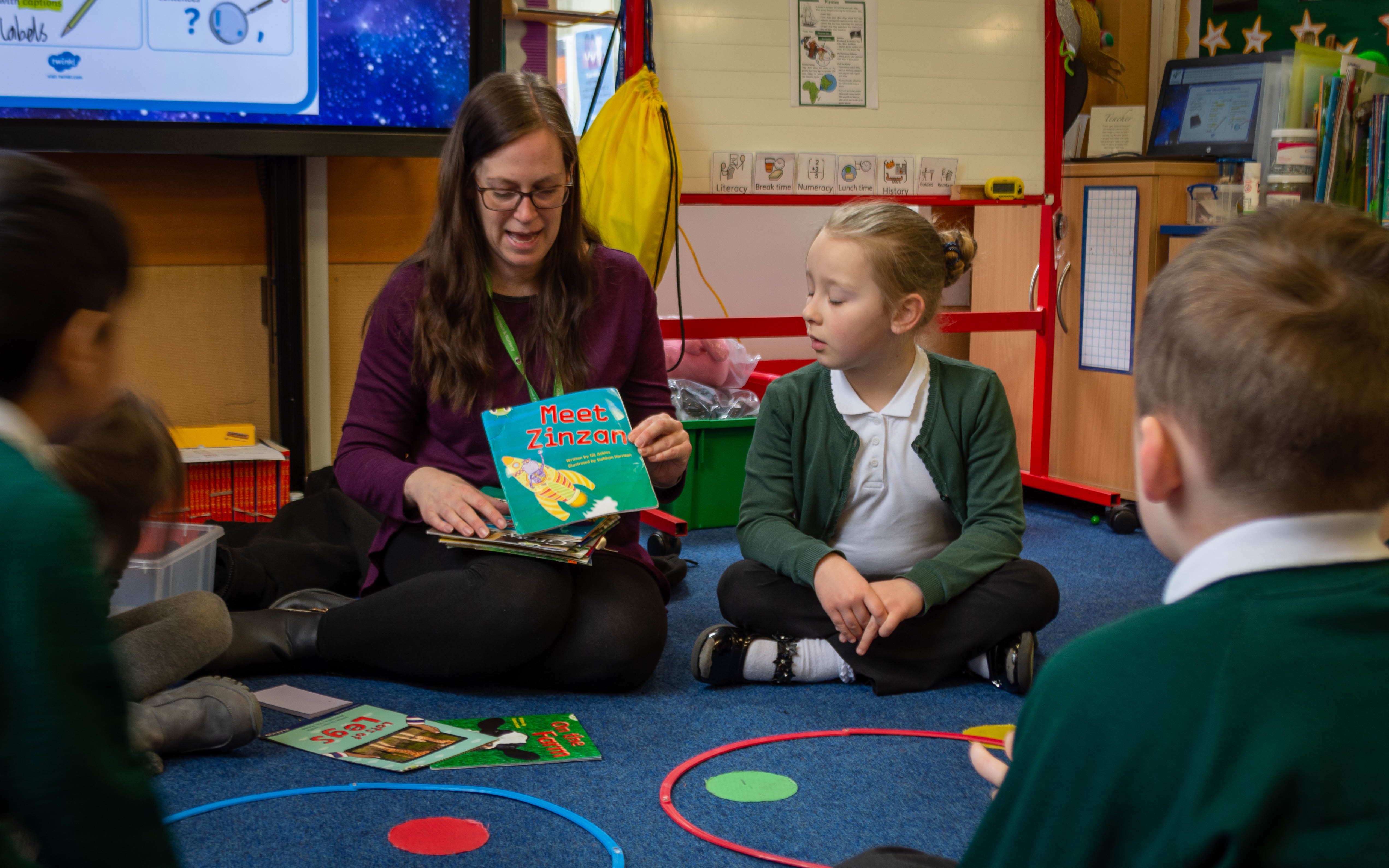
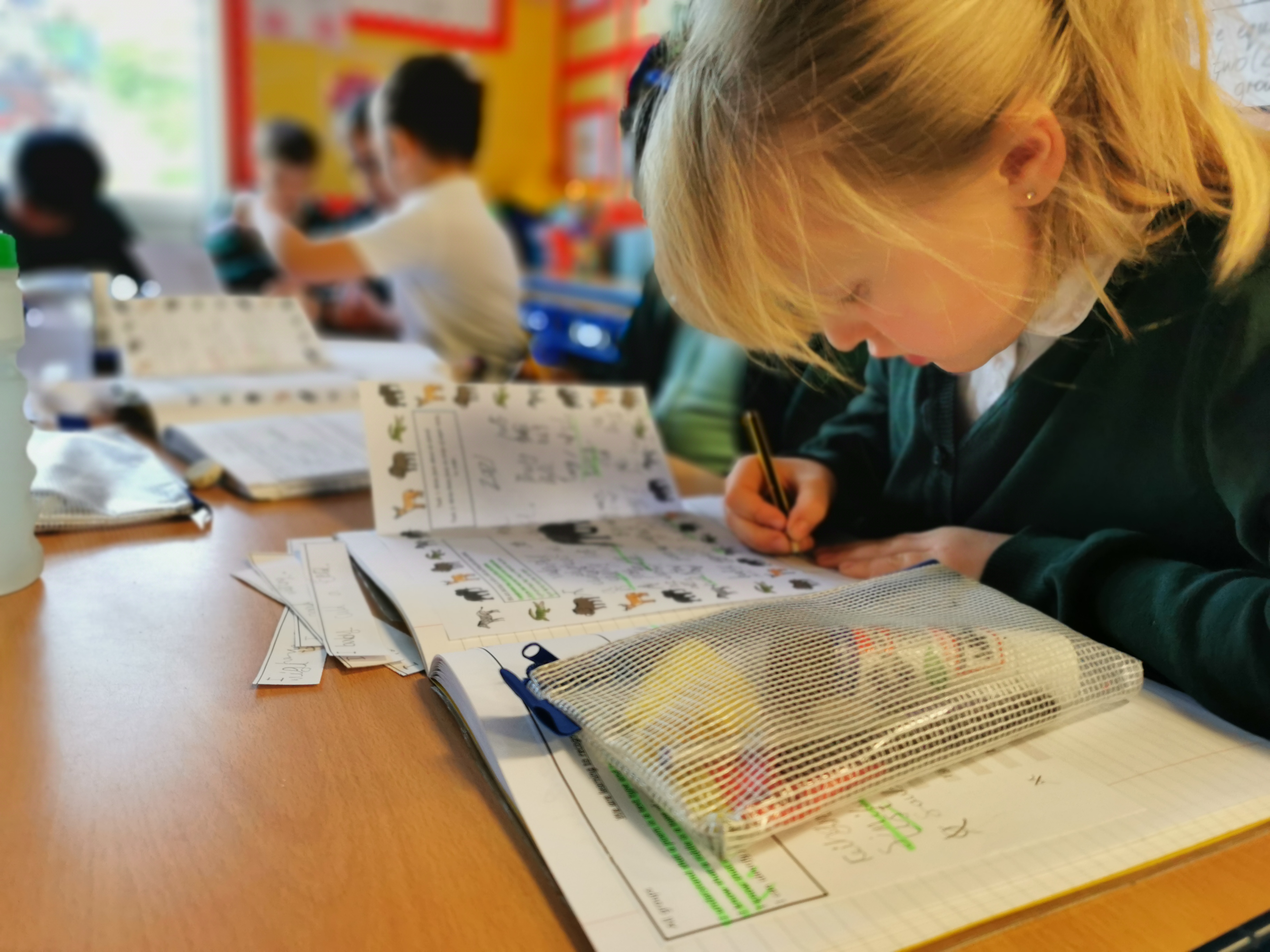
Reading

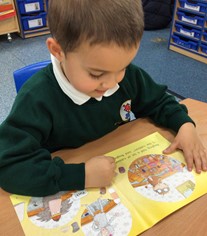
Subject Intent for Reading
At Hollinswood Primary School & Nursery, we aim to develop every child’s skills, knowledge and attitudes in order for them to become responsible, resilient, resourceful and respectful learners. We aim for children to leave our school being able to read fluently and effortlessly.
As reading is a complex skill with many components, Hollinswood Primary School has adopted a comprehensive and consistent approach to the teaching of these skills throughout the school to ensure our children have the resilience to tackle increasingly demanding texts.
Reading is a valuable and rewarding experience and children are encouraged to respect books and develop a love for reading and the written word. Children are encouraged to be responsible readers and adopt a love for reading beyond the realms of the classroom.
Laying a firm foundation in reading will allow access to all areas of the curriculum successfully; therefore, developing our children’s ability to be resourceful when learning new concepts. We believe that success in reading opens doors to a world of knowledge.
Reading policy
Click on this link for our Reading policy.
Reading Curriculum
This following document identifies when reading is taught throughout a week in school:
Reading lessons


The children in our Nursery setting access phase 1 phonic lessons before beginning the Bug Club Phonics programme, as it is useful for children to do some preparatory work on print conventions, letter knowledge and whiteboard use. The children in Reception, Year One and Year Two (autumn term) have daily phonic lessons. We follow the Bug Club Phonic scheme. See the phonics section of the school website for further information. Following the phonics lesson children will read a phonetically decodable book from our chosen scheme, matched to their phonetic ability. This book will contain the phonemes and common exception words taught that week. Children read the same book each day and take this same text home to help increase fluency when reading. Here is some more information about reading fluency:
Teachers follow the structure as suggested by Bug Club for the reading sessions. In addition to this the children also choose a book to take home to read for pleasure from the class library. The following document outlines how the reading lessons in Reception and Key Stage One classes develop across the week: Reading guidance
From Year 2 (Spring Term onwards) and Key Stage Two teachers plan their reading lessons following Kala Williams Read Master approach. The aim of this approach to the teaching of reading is to maximise teaching time to encapsulate a balance between pleasure and attainment by providing clear systematic practise with practise strategies and to develop probing readers who question what they read, seek clarity and achieve independence. The books used for the whole class reading lessons have been carefully chosen to ensure that texts are age appropriate, have cross curricular links or cover the protected characteristics. Whole class reading spine
Teachers follow the teaching sequence as provided on the ReadMaster website when planning their reading lessons. ReadMaster teaching sequence
The medium term plans identify how the lessons are differentiated within KS2.
Each term the school holds a poetry week. Teachers will plan poetry lessons that will be taught throughout their reading lessons on this week. Teachers refer to the poetry Medium Term Plans to support them with planning. Poetry Medium Term Plan
Once children have completed the phonics programme, class teachers assess reading age using Salford Reading Assessments. Children are then able to choose books to take home to read that are banded by reading age.
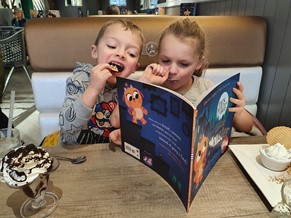
Story time
Story time happens daily in all year groups. Teacher plan their story time lessons using the teaching sequence as suggested by the English Hub and texts are chosen from the story time reading spine. The texts selected on this spine are age appropriate texts, which link to areas of the curriculum, following the curriculum Long Term Plan, or have links to protected characteristics. Where possible, texts are linked to authors so that classes can study an author of the month.
Drop and Read
From Year 2 upwards, Drop and Reads happen daily. Children read a book of their choice. Teachers use this opportunity to listen to children read 1:1, recommend age appropriate texts and check what children are reading at home.
1:1 Reads
Each child reads aloud to an adult at least once a week. We identify children who require more reads than this at half termly pupil progress meetings. Teachers record when they have listened to children read in a folder so we can track that all children are reading to an adult.
Parental engagement
Parents are encouraged to support their child become a fluent reader in a range of ways:
- Termly Reading Workshops led by the Reading Lead
- Parents are invited into school across the year to observe the teaching of phonics and reading
- Teachers promote reading on ClassDojo
- Recommended Reads identified on monthly newsletters.
- Engagement with whole school initiatives such as reading challenges.
- Ensure that reading at home is recorded in their reading diaries.
Recommended Family Reads
Do you struggle to choose a story to read at home with your child?
This attachment provides a list of suggested stories for Nursery, Reception, Year One and Year Two children.
These are stories that the children are not expected to be able to read themselves but for you to share with your child, that have age appropriate content.
Does your children like to read the same book over and over?
This is okay! Research suggests that on each rereading, familiarity with a story deepens and, with that, comes a greater emotional engagement. When children ask for a story to be re-read, in effect they are asking for another chance to explore the language, the characters and their feelings, and to relive the emotions they felt on the first reading. They hear the same words read in the same way and gain a sense of comfort in knowing what follows. They wait for their favourite bits, ready to join in or ready to be scared, even when they already know what happens. Their attachment to the story equips them to retell it and, when they have learnt to read, encourages them to read it for themselves.
This website recommended texts suitable for school years Nursery through to Reception and also provides texts you could read based on authors. https://www.thereaderteacher.com/
Happy reading!📚😁📚
Class library
To promote reading independence and to encourage a love for reading, all classes are equipped with an abundance of books for the children to take home. Each class library consists of fiction, non-fiction, and a range of genres eg adventure, mystery, science fiction etc. Staff at Hollinswood regularly replenish the class libraries to ensure a breadth of books are available to cater for a range of interests. The school council worked together with the Read Lead and link School Governor to decide what they would like to include in their class library areas. This was shared with staff and all classes organise their reading corners following their recommendations.
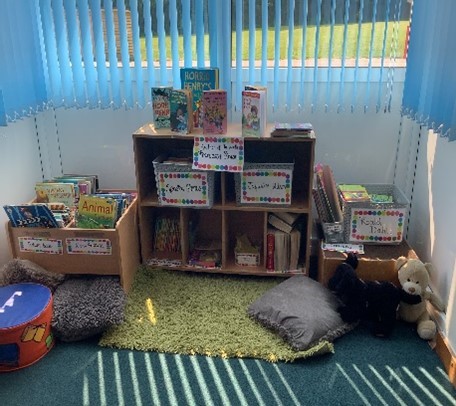 |
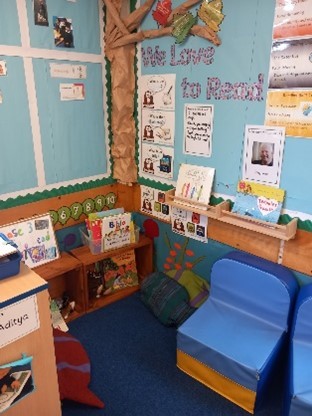 |
Writing

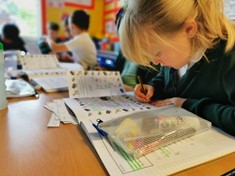
What is writing?
At Hollinswood Primary School we love to write!
Good writing gives your child a voice to share their ideas with the world and develop and explore their own personality.
The National Curriculum divides writing into two broad areas: transcription and comprehension. Transcription covers the technical aspects of writing: handwriting, spelling, grammar & punctuation. Composition is about articulating ideas and structuring them in speech, before writing them down.
Learning to write can be a tricky business, because good writing involves balancing all these different parts. There’s a lot for a child to juggle.
Subject intent
At Hollinswood Primary School & Nursery, we aim to develop every child’s skills, knowledge and attitudes in order for them to become responsible, resilient, resourceful and respectful learners.
Writing is an essential tool in effective communication. In order for children to develop into articulate, resilient and imaginative communicators, they need to be well-equipped with the basic skills to become life-long resourceful learners.
At Hollinswood, all children develop a genuine love and respect of language and the written word, through using a range of interesting and exciting contexts to motivate and inspire them.
Children develop an understanding of how widely writing is used in everyday life and, therefore, how important and useful the skills are that they are learning. Our intentions in writing are for children to write for a purpose, see themselves as real writers, take ownership and responsibility of their writing, and see writing as an interesting and enjoyable process.
How the curriculum is designed
The writing curriculum has been planned for using the following concepts:
- Transcription (including spelling and handwriting)
- Grammar
- Punctuation
- Composition
EYFS
In Reception, children take part in daily phonics sessions, where they learn transcription skills alongside taught phonemes and graphemes. Fluent transcription skills are a critical focus for the early years and key stage 1.
In Reception, composition and transcription will be taught separately. When focussing on composition, children can convey their ideas orally.
Carefully-planned provision is continuously accessible for pupils in both Nursery and Reception in order for them to develop their Reading, Writing and Speaking and Listening skills. These opportunities regularly link to whole class shared stories and themes and topics covered, supporting the development of subject schema. Quality adult-interaction with pupils ensures that the provision is being accessed appropriately and in a way that will provide experiences for them to practise developing core skills and make progress.
Year 1
By the beginning of Year 1, not all pupils will have the spelling and handwriting skills they need to write down everything that they can compose out loud. The national curriculum suggests using dictated sentences in Year 1 to apply and practise spelling. This means:
- Children get the practice they need to acquire fluent transcription skills (spelling and handwriting), which is the foundation for their progress in writing.
- Dictation activities enable pupils to practise and apply their spelling knowledge and segmenting skill to use the content they have been taught and to do so without having their working memories overloaded by composing sentences.
We adopt this approach whilst children in Year 1 are still mastering transcription skills. Once they have become more confident with this, they are then taught the knowledge needed for writing through the learning journey outlined below.
KS1 and KS2
In KS1 and KS2, we develop writing through four purposes. These are:
- writing to entertain
- writing to inform
- writing to persuade
- writing to discuss
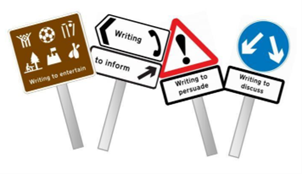 In these phases, teaching and learning activities will follow the same approximate structure over each writing unit. This writing journey will take place over a number of lessons.
In these phases, teaching and learning activities will follow the same approximate structure over each writing unit. This writing journey will take place over a number of lessons.
- Diagnostic assessment. This provides an opportunity for teachers to assess what the children know and what needs to be focussed on. This assessment will either be written, a concept task (eg role play) or a discussion task.
- Time to explore the genre. This will include a discussion about the Purpose (to Persuade, Inform, Entertain, Discuss), Audience and Text Type (features of the genre) and how these elements affect the writing choices that the author makes.
- Text deconstruction. Children will be given a WAGOLL (What A Good One Looks Like) which they can emulate. Children will be supported in ‘deconstructing’ the text so that they have a clear understanding of the elements required to write successfully in this genre.
- An engaging stimulus or a memorable experience for writing. Writing activities are planned which will have a ‘real’ audience which will increase children’s motivation to write. These are linked to whole class texts, the wider curriculum and trips, visits and visitors.
- Conceptualised construction. Children have an opportunity to independently write, using the knowledge they have learnt throughout the writing journey. Chidlren may write in chunks. The cognitive load involved in writing can be overwhelming for children as they have to consider many different elements at the same time therefore children may complete writing activities in ‘chunks’ over the course of multiple lessons.
- Editing and improving. Children will read through their work and using feedback from the class teacher/teaching assistant or their peers, they will make improvements to it.
- Independent Writing Task: At the end of the unit, children are asked to complete a different writing task in the same genre. This allows the teacher to assess their work and the progress they have made in that unit.
Vocabulary
The use of genres specific vocabulary is taught within each new unit of writing to encourage children to ‘magpie’ and include this within their own work. Children are encouraged to transfer vocabulary across different pieces of writing to increase their language bank. Children look at synonyms and are given the opportunity to practice using the new vocabulary in a variety of contexts.
Writing across the curriculum
Extended writing opportunities are regularly planned for across the curriculum. This encourages the children to be creative and flexible with their writing skills, applying what has previously been taught; e.g. writing a narrative set in Ancient Egypt or writing an explanation of how a volcano erupts.
Handwriting
The ability for children to write legibly is essential in order for them to demonstrate their true potential throughout their school careers (and their lives beyond school) as well as ensuring that they have the ability to communicate effectively using their writing. Nelson handwriting encourages development of an individual style in each child through carefully structured stages and fully covers the technical aspects of writing: letter formation, basic joins, printing, speed writing and slant. Nelson handwriting progresses from pre-writing patterns through to the development of an individual style.
Spelling
The National Curriculum divides writing into two broad areas: transcription and comprehension. Transcription covers the technical aspects of writing: handwriting, spelling, grammar & punctuation.
Ready Steady Spell is a progressive systematic spelling programme from Year 2 up to Year 6. It covers all National Curriculum expectations progressively for all these year groups. It provides full coverage, in a cyclical way, by providing opportunities to reinforce and embed learning systematically and interactively.
Key documents
Writing for a purpose long term plan
Whole school curriculum yearly overview
Writing to Entertain Progression Grid
Writing to Persuade Progression Grid
Writing to Inform Progression Grid
Writing to Discuss Progression Grid
Spelling Progression Grid Year 2
Spelling Progression Grid Year 3
Spelling Progression Grid Year 4
Spelling Progression Grid Year 5
Spelling Progression Grid Year 6
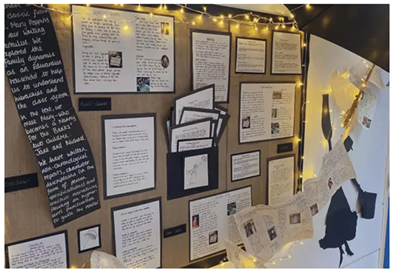
Phonics

Subject Intent for Spelling and Phonics
At Hollinswood Primary School & Nursery, we aim to develop every child’s skills, knowledge and attitudes in order for them to become responsible, resilient, resourceful and respectful learners.
At Hollinswood Primary School we intend to develop the children’s phonological awareness, ability to segment and blend words and read tricky words by sight in order to become fluent readers.
Delivery of lessons
At Hollinswood Primary School and Nursery, we follow the Active Learn Bug Club phonics programme. Children are taught at a stage appropriate to them and this allows them to understand how the sound of each letter (phoneme) links to the way in which that letter is written (grapheme).
In the Foundation stage (Nursery and Reception) and Key Stage One, all pupils take part in a daily phonics session, building on and extending their knowledge. They are taught to distinguish between everyday sounds, segment and blend words together and read/spell tricky words - which are the ones we cannot sound out.
This document shows the order of what is taught in phonics lessons throughout Early Years and Key Stage One and highlights what children are expected to know by the end of each half term in each year group.
Assessment
Each half term all children accessing phonics are assessed using the assessment materials provided by Bug Club. Following analysis of the assessment, children are then grouped for lessons accordingly and interventions are put in place to support where needed.
Children who are new to school are assessed upon arrival so support can be given immediately.
For those children who require the teaching of phonics in KS2 they receive phonics intervention where needed and are also assessed half termly. We use Rapid Phonics intervention to support pupils to catch up at a quick pace.
Supporting parents
Children are sent home books to read each week. This is the book that they have read throughout the week to help develop fluency and to continue practise applying the phonemes taught within that week. Additionally, children are provided a list of words each week to practise reading at home, which contain the phonemes taught throughout the week.
The Reading Lead holds parent workshops explaining how phonics is taught throughout school. Here is a copy of the slides from the latest workshop: Phonics Workshop. Following the workshop, parents are invited into lessons.
The following link provides support of how to articulate phonemes:
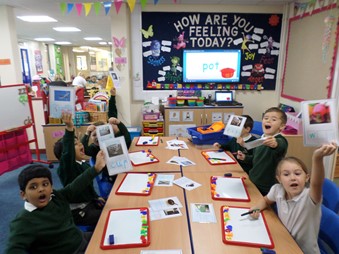
Mathematics
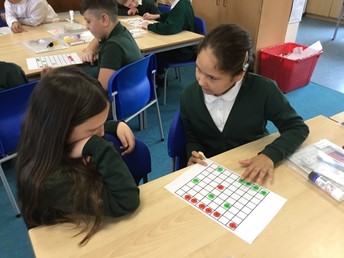
What is Maths?
In line with the 2014 National Curriculum our offer at Hollinswood Primary School is built around ensuring that pupils have an understanding of number, shape and space and measures. Mathematicians seek out patterns, problem solve and reason by applying the skills that have been embedded since the foundation stage. Mathematics is essential to everyday life and is integrated into all aspects of the curriculum. It provides foundations for understanding of the world and the ability to reason.
Subject intent
At Hollinswood Primary School and Nursery, we aim to develop every child's skills, knowledge and attitudes in order for them to become responsible, respectful, resourceful and resilient learners.
In Maths, pupils demonstrate resilience, by having high expectations of themselves. They tackle problems with increasing difficulty by using their prior knowledge. All pupils are encouraged to have a go and challenge themselves through the use of chilli challenges. Pupils are supported with visual models and practical equipment. Pupils are encouraged to be responsible for the resources and equipment they use to support their learning by independently selecting what will support them best. They are respectful of equipment, other pupils and answers that are given during a session. Building on prior learning through sequential teaching allows pupils to be resourceful by knowing which equipment and strategies will best support them. Through self and peer assessment pupils are responsible for their own learning by seeing any errors they have made and how to correct them.
How the curriculum is designed
At Hollinswood, we follow a mastery for all approach. This ensures that mastery mathematics is achievable for all pupils not just our high attainers. Teaching for mastery is a belief that all pupils can achieve by keeping the class working together so they can all access and master the mathematics. Taking a longer time on key topics to embed the learning. Mathematics is taught using White Rose small steps allowing more time to be spent on topics.
Maths lessons at Hollinswood focus on fluency, reasoning and problem solving: giving children the skills they need to become competent mathematicians.
The delivery of White Rose is supported through adaptive first quality teaching. We follow the Concrete Pictorial Abstract (CPA) approach which supports children when they are introduced to a new concept, working with concrete physical resources and pictorial representations leads to a better understanding of abstract concepts.
Fluency is developed through the use of Fluent in five, a daily set of arithmetic practice for Years 1-6. Regular practice of mental and written arithmetic skills is important in order to keep calculation skills fresh. Fluent in Five sessions help children to distinguish between mental and written methods.
Key documents
History
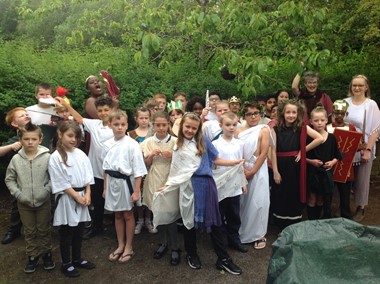
What is History?
History is the teaching and learning of past events, showing an understanding of why and how things occurred, being able to think critically about the past and challenge ideas using evidence.
Subject Intent for History
At Hollinswood Primary School & Nursery, we aim to develop every child’s skills, knowledge and attitudes in order for them to become responsible, resilient, resourceful and respectful learners.
At Hollinswood Primary School & Nursery we aim to develop every child’s skills, knowledge and attitudes for them to become effective learners. History is taught to develop the pupils with the confidence, competence and curiosity to face uncertainties, exercise their own initiative, develop personal responsibility for their learning and develop skills applicable in their lives outside the classroom. Furthermore, history is a subject with which pupils can develop critical thinking and analytical skills. We expect pupils to challenge evidence and use the skills from this subject across other areas of the curriculum. The makes them resourceful learners and enables them to see challenges as a positive thing. Ultimately building resilience both inside and outside of the classroom.
Our aim is to ensure children have rich, deep and meaningful knowledge that broadens their understanding of the world around them, from past to present, which ultimately makes them resourceful learners. Substantive and disciplinary knowledge is developed concurrently so pupils develop rich and layered schema both in terms of what happened in the past, but also how the past is studied. Further to this, history is a subject in which pupils are given unique opportunities to develop critical thinking skills, as the subject offers opportunities for pupils to make connections across learning under the umbrella of understanding the world. These connections we intend to be made are outlined in brief detail below, with the aim of creating resourceful, critical thinking pupils, who challenge ideas appropriately by asking questions.
Pupils are given opportunities to think about how skills learnt in this subject can be applied across their learning. The intention is for pupils to, by year six to develop an understanding that enquiry is an approach adopted in different ways to study all humanities subjects and the science. Concepts such trade, religion and beliefs, settlement and art and culture, are present not only in our history offer but, are linked to other substantive concepts in R.E., geography and modern foreign languages. In history, they are taught about the history of settlements, while in geography the pupils focus on how these settlements link to site and place. Processes and change, which is a core concept in our geography curriculum, also links to the ideas of causation and change in history, and supports pupils develop pupil schemas around chronology. Changing places and spaces, is focussed on in our heritage work, which combines using maps from the past in our local area as historical sources, while building their knowledge of changes in settlement and developing their geographical skills. Essentially our history offer is enriched by ideas, concepts and disciplinary knowledge. Ultimately these connections and links, rich knowledge and schema building, assist pupils to be resourceful learners; whereby, they can link key substantive and disciplinary knowledge across subjects. and knowing how these subjects are connected, while learning the unique nature of the study of history itself.
In History, we learn about a wealth of different cultures from the past and we acquire knowledge and understanding of different people, places and settlements. In history, we encourage our pupils to have an increased knowledge of other communities, with respect and understanding of what it means to be a citizen in a multi-cultural society. The work completed around heritage across school ensures that ideas of diversity, difference and pride in their community is encouraged.
Furthermore, diversity is embedded in the learning for pupils at Hollinswood Primary School, which teaches them to be accepting of difference and embrace how different cultures have shape and still shape the society they live in. The pupils are taught to be respectful of others and that their voices are important by studying a broad and diverse range of people from the past. The diversity element within our history offer and focus on art, cultures and ideas from the past, ties into concepts present in other curriculum areas: in the geography we aim to enrich schemas around diversity by exploring the concept of cultural awareness and diversity; from Spanish about the concept of culture and traditions is taught; and in R.E. pupils are taught about beliefs and traditions. Within the history curriculum we draw upon the concept of religion and beliefs to enrich pupils understanding further. These connections, again intend pupils to be respectful of differences and diversity, while embedding pride in their area, country and place through our heritage work.
History is a subject within which pupils leave Hollinswood Primary School and Nursery with a sense of belonging to a community. Being part of the community and responsible for shaping it’s future comes from this sense of belonging that is enriched by the curriculum offer in history. The overall intent is for pupils to leave our school with the confidence and skills to self-evaluate, challenge ideas appropriately, make choices and become effective learners. As a result of the broad curriculum offer, offered through our teaching of history, and tied to other subjects, our children will have the mental agility and emotional stamina needed to thrive in an ever-changing society. This helps children develop into responsible, resourceful, resilient, and respectful learners.
How the curriculum is designed
The history curriculum is framed around the key aims, outcomes and knowledge in the national curriculum. In line with the 2014 National Curriculum our offer at Hollinswood Primary School is built around ensuring that pupils leaving the school have a secure chronological understanding of the past. Chronology is the golden thread in the history curriculum offer. This is based around research which supports the idea that children with a better chronological understanding develop a more secure knowledge of abstract concepts in the past. Essentially this research, and evidence through monitoring of the implementation of our curriculum shows this helps learning stick for pupils. The golden thread in this subject and ambition is that all learners leave Hollinswood Primary School with clear chronological knowledge from the Stone Age to the present day and know that human history is connected by key concepts and themes across these time. Substantive knowledge and six key concepts are then hooked on to this chronological narrative. Children develop their disciplinary knowledge around clearly set our substantive knowledge throughout school. We teach history in this way to enable children to develop strong and meaningful connections- building schema- that is richly developed and embedded. There are seven key substantive concepts in our geography curriculum which are: settlement (community), power, trade , art and culture, religion and beliefs and warfare and invasion. The teaching of chronology and these concepts therefore a key focus for all pupils in all phases and how this is sequences, is outlined below and can be seen in the medium term planning documents outlined below.
Children are also taught how history is studied, which is outlined in the long term knowledge and skills progression grid. The knowledge for each unit of work for each year group is broken down into terms in the medium-term planning documents. Staff use this to ensure short term planning helps children learn key disciplinary and substantive knowledge that ensures that the long-term memory of ideas and abstract concepts is continually built on and taught from Nursery and EYFS through to year six.
EYFS
The long-term plan ensures that learning is sequenced so that pupils in Nursery and EYFS begin their learning by understanding the history of themselves and their family before they study history in line with their developing understanding of number. In EYFS the curriculum design is designed both to meet the Understanding the World element of the EYFS statutory framework and are also directly linked to the national curriculum in history. These fall under the Understanding the World and more broadly encouraging the children rich opportunities to develop their communication and language skills through a variety of learning opportunities linked to history. These statements can be found in the EYFS statutory framework and are defined in the skills and knowledge progression grid, as well as the medium terms plans linked below.
Ideas of settlement, which is tied to children developing a sense of belonging and community is developed across EYFS. This concept is framed and taught alongside, the geography, science and R.E. curriculums, which all focus on language acquisition, the immediate environment and pupils sense of self, within the school environment. In the Autumn term the specific history focus, is on families and family trees, where the children focus on who they are and their own life in time. In the Spring term, the children look have a heritage focus and as their understanding of time passing and space progresses they broaden their view of the world to understand the idea of community within school. In the Summer term, children are deliberately exposed to ideas and vocabulary associated with farming to re-enforce ideas of community, settlement, which includes- for example- farming in the summer term. This key learning enables them to build schemas that link directly to future learning around farming in the Stone Age, Benin, Egypt and Greece in Key Stage One and Key Stage Two. Vocabulary development and progression ensures that the children build foundations to be able to access the Key Stage One Curriculum.
KS1
In Key Stage One, pupils are given opportunities to develop an awareness of the past, using common words and phrases relating to the passing of time. The learning is sequenced backwards (from now to the Fire of London) so that all pupils have a secure concept of the ideas of events, people and changed within and beyond living memory. Further to this, they are encouraged and expected to use a wide vocabulary of everyday historical terms, while being exposed to how the study of the past is structured. Their enquiry skills are at the heart of the learning process and they ask and answer questions, choosing and using parts of stories and other sources to show that they know and understand key features of events. They are also taught to understand some of the ways in which we find out about the past and identify different ways in which it is represented. By the end of Key Stage One, the children are expected to know that stories from the past extend beyond living memory.
In Year One, the pupils start the Autumn term by looking at the way toys and expression of play have stayed the same and changed within living memory. This focusses the children on the past moving backwards from now. The teaching sequence, images and artefacts used, also begin to develop language use and disciplinary knowledge associated with the study of the past. In the Spring term, the children in year one, have a focus on heritage and changes in settlement, jobs and trade in the local area just beyond living memory. This embeds the idea of settlements, changing and is a cross-curricula unit, which begins to develop schemas in both history and geography, both in terms of substantive and disciplinary knowledge. In the summer term, the children focus on the achievements of Florence Nightingale, while developing knowledge around how the past is studied.
In year two, the children begin by completing a unit of work on Mary Seacole and link their learning back to their work in year one on Florence Nightingale. The children focus on the idea of warfare and invasion, its impact and also why Mary Seacole and Florence Nightingale’s gender, made their work challenging. Furthermore, Mary Seacole, was also challenged because of her race. The children look at the position of the Crimea, Russia and the climate to better grasp the achievements of both Mary Seacole and Florence Nightingale. In the Spring term, the year two pupils focus their work again on heritage, using a range of maps as sources, while also using artefacts to look at working conditions for miners. This knowledge prepares them to study a local miners riot in year three, the Cinderloo uprising. This story is shared with the pupils in year two. Again, the ideas of settlement, but also power are introduced in this unit of work. In the summer term, the children are taught about the Fire of London, which begins to really introduce the ideas of power, settlement, changes and by this point children are expected to have a firmer grasp on key vocabulary and ideas around the study of the past. The children are taught about where the Thames and London are in geography lessons, to enable them to grasp a sense of place and space when studying the Fire of London. By the end of year two, the children should have a secure knowledge that history moves in a linear way, backwards in time and remember key people and stories from the past. Pupils are expected to know what the words within and beyond living memory mean.
KS2
In Key Stage Two, this shifts so that the children develop a clear narrative of the history of the British Isles from the Stone Age to the Battle of Hastings (1066). This encourages children to grasp the idea that chronology moves forward in time from the ancient past to the present. In year three pupils focus on the narrative around the development of human settlement and key changes between the Palaeolithic, Mesolithic and Neolithic periods. The children are taught the key aspects of settlement in these time periods, looking at artefacts that archaeologists use to find out about the ancient past. In the Spring term, the children focus on heritage again, looking in more detail at the story of the Cinderloo riot. Ideas of protest, rebellion and people power are explored, as are ideas around changes in settlement. Geography work is completed in this term, with children using maps to explore key areas where this riot happened. In the summer term, the children finish by looking at the changes brought about to Britain by the Roman invasion, which is tied to late settlement in the bronze age of a local Stone Age tribe and a focus on the Roman city of Wroxeter. The pupils also look at the impact the Romans had on de-forestation in Europe during geography lessons.
In year four, the narrative of the British Isles continues, with a focus towards reasons for settlement, which is taught across and focussed on in both geography and history across the year groups. Ideas of change, when invasions occur and the settlement of people is taught in the Autumn term, with a look at the Anglo-Saxons and a close focus on significant historical finds (Sutton Hoo) and how historians interpret these artefacts. In geography in the Autumn term, children learn, dates and ideas re-enforced about settlement and the Roman empire, when looking at states of matter and natural disasters, with a specific focus made on Mount Vesuvius and Pompeii. In the Spring term, the children place events at Cinderloo in a wider context to look at how changes nationally affected the local area and caused uprisings and unrest. Furthermore, in the Spring term, the children look at ideas of settling and migration over time in geography. In the Summer term, the pupils study the Viking invasion, looking at why, how, where and when they invaded and changes to Britain as a result. Finally the children end the unit of work by looking at 1066 and the end of this period in British history. By this point, the children are being taught how key concepts link ideas across the narrative of the British Isles: developing secure schema around chronology, as well as substantive and disciplinary ideas and concepts.
In year five the children then study how events ran concurrently in the world alongside events in Britain. History and geography units look at settlement in Greece and its concurrence with events in Britain previously studied. Children then explore ideas of achievement, why civilisations are considered great and legacy. The idea of legacy is continued in the Spring term when the children look at the re-emergence of the modern Olympic games in Much Wenlock. Again, this unit re-enforces the concepts of within and beyond living memory, whilst linking units of work studied. Finally, the children in year five complete geography and history units of work around Egypt. This is a depth study, which draws all ideas and concepts taught within school so far. Again, the idea of concurrence is drawn upon for pupils.
In year six, the pupils look at the Kingdom of Benin, with a narrative study, which explores how the Kingdom came to be and developed into an empire, leaving behind a legacy of great art and culture. At this point, the children use substantive concepts to frame their knowledge, drawing links to times studied previously, while really starting to engage with the enquiry process used by historians. Ideas of slavery, exports, imports and globalised trade are linked to knowledge the children have acquired in history around the transatlantic slave trade and are further explored in geography by looking at the globalisation of trade. In the Spring term, the children tie events in Benin and ideas of absolute monarchy and power to Tudor England, which draws their learning back to the present. Ideas of power, gender and monarchy, and religion and monarchy in Tudor England, bring their learning back towards the present. Finally, the children look at the English Civil War, which ties to their knowledge of civil war in the Kingdom of Benin. By the end of year six key substantive ideas are drawn upon and expected to be known by pupils in year six and while discussing, writing or analysing sources, they naturally make links conceptually between the key concepts in history and wider studies in the humanities subjects. These ideas and the overlapping of them prepares them for key ideas around power, religion, church and state in the Key Stage Three national curriculum.
Key documents
The above statements are broken down and defined into five elements within the progression documents and the vocabulary across each area is progressed. This is how disciplinary and substantive knowledge progresses across the school. The skills pupils start to develop are: knowledge and understanding of events, causation and change (the what and why of the past); historical interpretation (uncovering the past); historical enquiry (investigating and developing questioning skills) and chronological understanding (when things happen).
Forest School and Outdoor Learning Roadmap
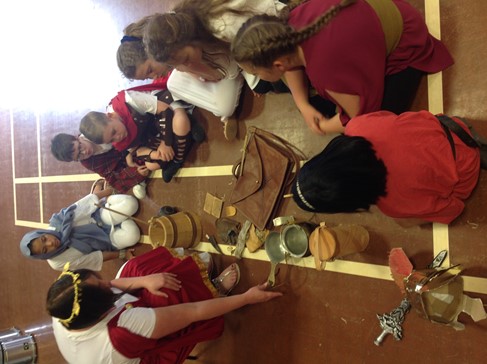
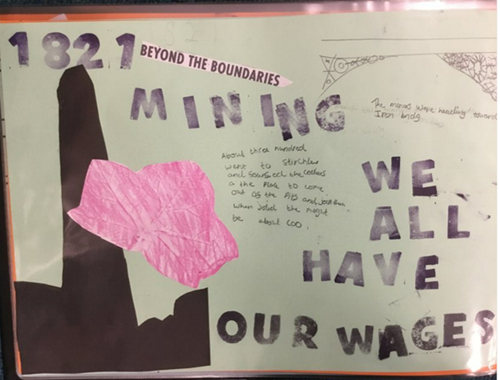
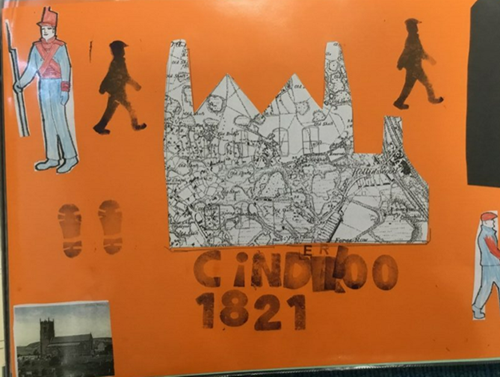
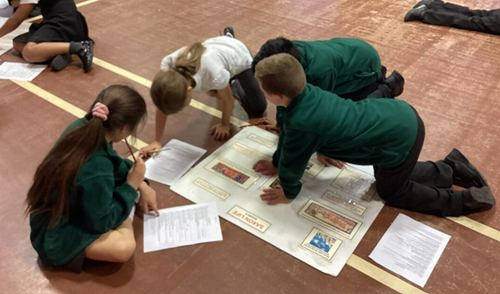
Geography
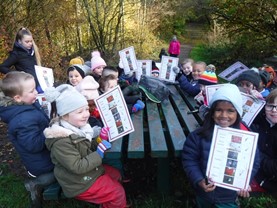
What is Geography?
Geography is about developing the knowledge of diverse places, people, resources, and natural and human environments. This equips us to gain a deeper understanding of the Earth’s physical and human processes.
Subject Intent for Geography
At Hollinswood Primary School & Nursery, we aim to develop every child’s skills, knowledge and attitudes in order for them to become responsible, resilient, resourceful and respectful learners.
At Hollinswood Primary School & Nursery we aim to develop every child’s knowledge skills and attitudes for them to become effective learners. Through the teaching of Geography, we aim to promote our four key values, supporting each child to become more respectful, resourceful, resilient and responsible.
Our aim is to teach geography to encourage pupils to know more about the changing world around them, being aware of and re-acting to change, which is part of being a modern citizen in Britain and the wider world. Further to this, geography is a subject in which pupils are given unique opportunities to develop critical thinking skills, as the subject offers opportunities for pupils to make connections across learning under the umbrella of understanding the world. Pupils by the end of year six should fully understand and be able articulate the idea of interconnection between human and physical geography.
In Geography, we learn about those who come from a wealth of different cultures and we acquire knowledge and understanding of different people and environments. In Geography, we encourage our pupils to have an increased knowledge of other communities, with respect and understanding of what it means to be a citizen in a multi-cultural society.
We encourage resourcefulness in Geography by using a wide variety of sources, including maps, the internet and photos to establish the location of countries, counties, cities, coasts, rivers, sea and oceans. Pupils are also expected to be resourceful in drawing upon their knowledge of the key concepts: trade and settlements to build rich knowledge that lends itself to seeing connections across places, spaces and time.
Resilience is promoted in Geography through all key concepts and particularly within fieldwork, which is completed in all weathers. Fieldwork is used to encourage enquiry and allow for deeper learning of geographical concepts. Furthermore, the interpretation and geographical and map skills needed to investigate places around the world, is challenging cognitively for pupils. We expect them to problem solve when facing challenges. These skills will set pupils up for future education and will be used throughout life.
Responsibility in Geography is a cornerstone of our offer, as we teach children the importance of our world and how to keep it safe. Children are encouraged to appreciate nature and to take responsibility for environmental issues. Sustainability is a key focus in our wider curriculum offer and pupils are taught explicit units linked to sustainability and the environment, which enables them to develop a sense of responsibility for their community and the world. Furthermore, in the Spring term, pupils are encouraged to complete fieldwork linked to heritage, which enriches their understanding of belonging and responsibility in the community.
We expect pupils to challenge evidence and use the skills from this subject across other areas of the curriculum. For example, the geography units of work overlap closely with those within the science curriculum and key concepts such as settlement and trade make those connections explicit to pupils. During forest school lessons, the children are expected to use their map skills and apply these using their geographical knowledge outside the classroom and in the local area. This makes them resourceful learners and enables them to see challenges as a positive thing, where unfamiliar places are opportunities to learn more and grow as people. Ultimately building resilience both inside and outside of the classroom.
How the curriculum is designed
The geography curriculum is framed around the key aims, outcomes and knowledge in the national curriculum. Knowledge is a key element of our curriculum offer and this is balanced alongside the skills needed to be effective geographers. To enable children to develop strong and meaningful connections- building schema- that is richly developed and embedded, there are seven key substantive concepts in our geography curriculum which are: interpretation, scale and space, settlement and place, trade and connections, environment and environmental impact, processes and change (time) and cultural awareness.
Geographical skills are taught and layered throughout each unit of work and enriched via opportunities during Forest School to further develop their fieldwork knowledge and skills. Children are also given opportunities to complete fieldwork in each year group across the school. Fieldwork is embedded through the curriculum itself, but also enriched through Forest School, residentials and our focus on heritage across school.
Through design, retrieval practices and explicit teaching of connections from geography to history, Spanish (MFL) and science, pupils are able build rich schemas and embed ideas in their long term memory. For example, ideas of trade, settlement, change, map use and culture are all embedded in history, as well as geography. The connections to science are also made clear through the concept of processes and change: pupils are taught to make explicit connections both conceptually but also in terms of how units across different studies are linked together. The idea of earths processes is linked to science and states of matter.
In geography, we also focus on contrasting and comparing studies from the United Kingdom to Spanish speaking (non-European countries). The concept of cultural awareness grows across school to show pupils how diverse our planet is. The place of Spain and Spanish speaking countries, is also taught in MFL, as is the idea of culture. The idea of how places are diverse but also connected is taught to pupils to help begin to understand interconnection in culture within places in the world.
EYFS
In the EYFS framework, children are expected to develop a growing sense of community and belonging and they begin their journey on the geography curriculum by developing a sense of space and belonging to the classroom. Conceptually the curriculum across EYFS and across school builds each unit of work around pupils growing, developmental idea of space and place. The key concepts across EYFS are drawn from the EYFS framework; therefore, the children focus on developing a sense of belonging, community, heritage and space and places. Fieldwork is a core component of all units of work in EYFS, as this enables children to develop their sense of space, scale, as well as create foundations by exposing children to the idea of observing the world around them and gathering evidence.
The pupils in EYFS explore their space by looking at materials in their environment which are linked to human and physical geography. Their vocabulary is developed through the environment and across school, while they broaden their understanding of processes in the world by looking at the weather and changing seasons. These ideas develop, while human geography is explored as they look at their relationship to spaces, objects, materials and living things. Pupils learn about different communities and traditions and compare themselves to others in their local environment. The children complete their learning journey in EYFS by starting to look at what a farm is and how people use land for farming, which begins to create a later foundation for learning about ideas of farming, settlement, place and changes in human history linked to land use.
KS1
Pupils develop their knowledge about the world, again through their developing conceptual and spatial knowledge. The children begin by exploring and making sense of the human and physical geography in their school grounds, before expanding this out into the local community, the United Kingdom and our seasons and climate in a broader global context. Pupils also use subject-specific vocabulary relating to human and physical geography and begin to use geographical skills, including first-hand observation, to enhance their locational awareness. At all times, pupils are exposed to a wide range of maps, survey maps, globes and atlases so geographical skills and interpretation skills develop. By the end of year one, pupils will have developed a broader sense of space and place, which will enable them to grasp geographical concepts larger in scale in year two.
In year two, the children their sense of how place and space are linked to people and connections. They are taught about the seven continents, drawing out connections to an individual from a history unit of work (Mary Seacole). This sense of climate, space and place, builds the idea of interconnection between people and places.
In the Spring term the children connect again with their local community (heritage), this time using fieldwork skills to develop a sense of how land use has changed in the local area. Furthermore, collecting evidence to show their growing understanding. Finally, the year two pupils finish by connecting the story of the Fire of London, to the development of ports and major cities, contrasting London with a non-contrasting European (Spanish speaking country). This link to Spain enables children to begin to gather a sense of culture, diversity and languages being shared globally.
KS2
Pupils extend their knowledge and understanding deeper into the local area, connecting topography to settlements and the Stone Age. This includes opportunities for fieldwork in the local area. This focus between settlements, land use and movement between settlements and sites by people continues to be developed, as the pupils move through year three, four, five and six. The idea of changes across time, begins to develop their sense of interconnection between human and physical geography.
Furthermore, the children in year three and four are taught how natural disasters (science and states of matter), affected, and still affect settlement, agriculture and farming. The pupils finish year four, preparing through measuring space, place, position and time by studying latitude and longitude. Pupils develop their use of geographical knowledge, understanding and skills to enhance their locational and place knowledge.
In year five, the focus shifts to grow their sense of exact positioning globally and how this affects climate, trade and settlements. Pupils link their knowledge to their studies in history on Ancient Greece and its legacy, further embedding the idea of place and space changing and staying the same over time. As part of our sustainability curriculum, year five are our plastic free champions and complete fieldwork in school and on the school grounds around plastic waste and plastic pollution. They gather, collect and analyse this data and present their findings to school with the support of our sustainability lead and champion and the eco-committee in year six.
During the Spring and Summer terms, the children are taught how humans are affecting the environment, before being exposed to the idea of erosion on the Nile, Severn and the UK coast.
In year six, the children connect learning around Africa, biomes, climate and natural resources to the history of trade and global economics. Their knowledge- in the interpretation of maps – which are also used as historical sources is used to link ideas of place, people and space. This knowledge is drawn through place and time to now and in the geography lessons, children are taught how site and settlement, lead to trade, growth and connection: this they are taught is interconnection. Finally, the pupils’ study sustainable living and our choices linked to our climate before conducting individual enquiries that the pupils investigate. In the summer term, the year six pupils complete their fieldwork study through Forest School, where they gather information about living things within their local area, before analysing the results.
Key documents
Forest School and Outdoor Learning Roadmap
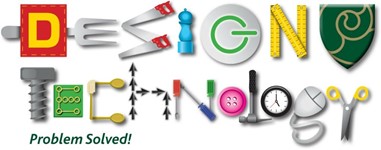
What is Design and technology?
Design and Technology is an inspiring, hands-on and unique subject. Using their creativity and imagination, pupils can design and make the most innovative products for a variety of different purposes. Through Design and Technology, pupils can listen to and adopt the ideas of others and create something fantastic that could support their community.
Subject Intent for Design & Technology
At Hollinswood Primary School & Nursery, we aim to develop every child’s skills, knowledge and attitudes in order for them to become responsible, resilient, resourceful and respectful learners.
In D&T, pupils are encouraged to be responsible members of the school, the local and the wider community. They are taught methods of innovation that could be used to support their local and wider community through a hands-on, creative and imaginative curriculum.
Through a context rich curriculum that goes beyond the school walls, pupils are encouraged to have high expectations for themselves and are given the confidence to aim high and to be the very best that they can be. When faced with a problem, pupils are encouraged to be resilient and resourceful, to be passionate in overcoming obstacles and alive for a challenge.
We see excellence in teaching and a love of learning as a key to succeeding in life. In a supportive, positive and caring environment, pupils are encouraged to develop self-respect and be respectful of the ideas, attitudes, values and feelings of others regardless of race and culture.
We encourage the children to have high expectations and to contribute towards, reflect on and shape their role as learners - in addition to being responsible members of the school, the local and the wider community.
How the curriculum is designed
In EYFS pupils use and explore a variety of materials, tools and techniques, experimenting with colour, design, texture, form and function.
In Key Stage 1 pupils explore and build structures and mechanisms such as levers, sliders, wheels and axles. The pupils also explore joining and finishing techniques in textiles.
In Key Stage 2 pupils explore more complex structures and mechanical systems such as gears, pulleys, cams, levers and linkages. They also use electrical systems in their products and apply their understanding of computing to program, monitor and control their products.
Pupils in both key stages are also taught how to cook and apply the principles of nutrition and healthy eating.
Pupils follow a simple process when making a product:
Design Make Evaluate
Key documents
Geography, Science and D+T Roadmap
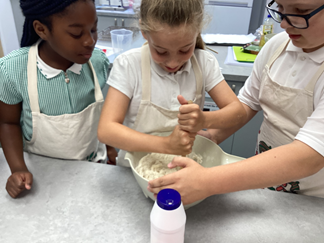 |
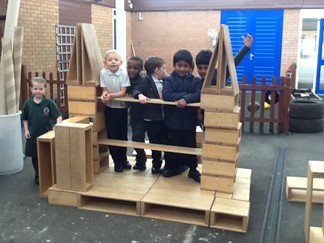 |
 |
|

Computing
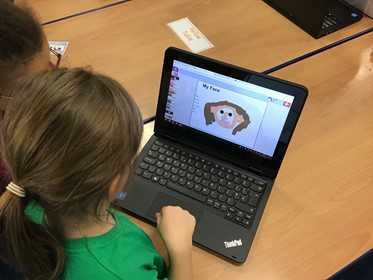
Subject Intent for Computing
Our Computing curriculum gives children the skills, knowledge and understanding of computing they will need for the rest of their lives. They will learn how computers and computer systems work, how to design and build programs, develop their ideas using technology and create a range of content.
At Hollinswood Primary School & Nursery, we aim to develop every child’s skills, knowledge and attitudes in order for them to become responsible, resilient, resourceful and respectful learners.
In Computing, pupils are taught to be responsible with the IT equipment, carrying it, using it and putting it away in a respectful way.
Resilience and resourcefulness are shown in Computing when children need to persevere when logging on, fixing code, solving problems and helping each other by passing on their computing knowledge and skills. Our children demonstrate these values from a young age.
Pupils are taught and show respect when listening to each other’s views on how to keep safe online and evaluating the work of their peers. From a young age, pupils learn that their behaviour online towards their peers should show the same level of respect as offline.
What is Computing?
Computing has links with mathematics, science and design and technology. The core of computing is computer science, in which pupils are taught the principles of information and computation, how digital systems work and how to put this knowledge to use through programming. Computing also ensures that pupils become digitally literate – able to use, and express themselves and develop their ideas through, information and communication technology – at a level suitable for the future workplace and as active participants in a digital world.
What are pupils taught in Computing?
In EYFS pupils learn about cause and effect through programmable toys such as Beebots and robot mice. They will also use simple programs on the computer.
In Key Stage 1 children continue to learn through programmable toys and will start to create their own simple programs. They will begin to learn to code and be introduced to algorithms. They will create, edit and save content in programs such as Word or Purple Mash. Pupils also begin to learn about keeping safe online.
In Key Stage 2 pupils will continue their coding journey using a variety of apps and programs such as 2Code and Scratch. They will collect, analyse and present data in a variety of ways and discover how to use search engines effectively. Pupils will learn how to keep themselves safe online, on social media and in computer games.
Curriculum Design:
The Computing curriculum is designed around the three strands of the National Curriculum - digital literacy, computer science and information technology. One strand is taught each term across the whole school. We begin with digital literacy in the Autumn term as this covers the majority of the online safety content and is a good way to start a new school year. As each year group is studying the same strand at the same time it is easy to see how the learning progresses throughout the school.
Click on the links below to view our medium term plans:
Web links:
Here are some of the sites the children regularly use in their Computing lessons –
https://hourofcode.com/uk/learn
Below is a useful video from code.org which explains the importance of teaching coding.

Music
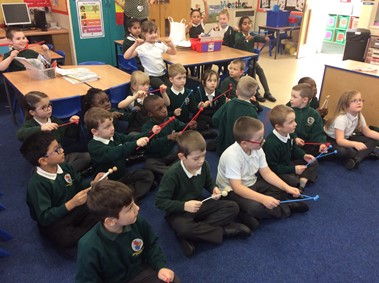
What is music?
Music is an art form that puts sounds together in a way that people like or find interesting. Most music includes people singing with their voices or playing musical instruments. It can be used to express a range of experiences, environments, and emotion.
Subject Intent for Music
At Hollinswood Primary School & Nursery, we aim to develop every child’s skills, knowledge and attitudes for them to become responsible, resilient, resourceful and respectful learners.
Children are taught about instruments and how to be responsible in caring for their instruments. Through performing and composing together, children acquire a sense of group identity and togetherness, developing respectful relationships with their peers.
The teaching of Music develops children’s ability to listen and appreciate a wide variety of music and to make respectful judgements about musical quality. Pupils are encouraged to be resilient and resourceful when composing and performing their own music, increasing their self-discipline and creativity.
As an integral part of culture, past and present, music can help children to understand themselves and relate to others in a respectful way. In a supportive, positive and caring environment, pupils are encouraged to develop self-respect and be respectful of the ideas, attitudes, values and feelings of others regardless of race and culture.
How the curriculum is designed
The music curriculum sets out sequences of learning in the following key areas which, when taken together, all contribute towards the steadily increasing development of musicianship:
- Singing
- Listening
- Composing
- Performing/ Instrumental Performance
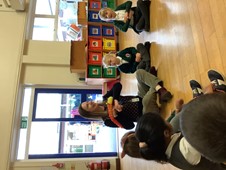 |
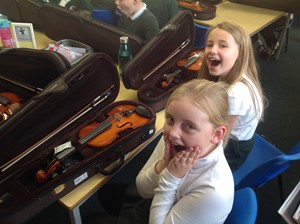 |
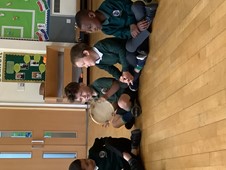 |
EYFS
Children sing songs, make music and dance. Children experiment with different sounds and ways of changing them. They experience music from around the world.
Key Stage 1
Children are taught to, use their voices expressively and creatively by singing songs and speaking chants and rhymes. They play tuned and un tuned instruments musically. The children have the opportunity to, experiment with, create, select and combine sounds using the different dimensions of music.
Key Stage 2
Children are taught to play and perform in solo and ensemble contexts, using their voices and playing musical instruments with increasing accuracy, fluency, control and expression. Children will improvise and compose music for a range of purposes using the different dimensions of music. Children will use and understand staff and other musical notations.
In Harmony
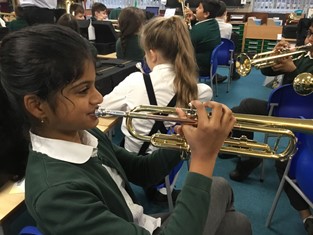
In Harmony is a national programme that aims to inspire and transform the lives of children, using the power and disciplines of ensemble music making. The children are taught to read music and play instruments by professional musicians. Year groups learn different instruments, so that orchestras can be formed where the children play together. Young musicians on the programme, work with a wide range of professional musicians and educators to explore their potential through music.
These are the instruments currently being taught in each year group:
|
Year group |
Instrument |
|
Two |
Percussion (glockenspiels) |
|
Three |
Violin and cello |
|
Four |
Violin and cello |
|
Five |
Flute and clarinet |
|
Six |
Trumpet, trombone and French horn |
Key documents
Art

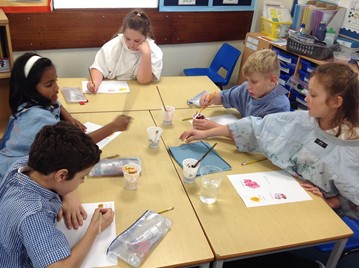
What is art?
Art at Hollinswood gives our pupils the opportunity to develop art as a means of communication, being able to convey their own ideas and feelings. It also supports them in seeing and understanding the world and developing their own perspectives.
We want out children to foster an enjoyment and appreciation of the visual arts, and a knowledge of artists, craftspeople and designers.
Subject Intent for Art
At Hollinswood Primary School & Nursery we aim to develop every child’s skills, knowledge and attitudes in order for them to become confident, independent and inspired learners. Through the Four R’s (respect, responsible, resourceful and resilience) we encourage the children to have high expectations and to contribute towards, reflect on and shape their role as learners - in addition to being responsible members of the school, the local and the wider community. Through a context rich curriculum that goes beyond the school walls, children are given the confidence to aim high and to be the very best that they can be, being resourceful and respectful artists and humans. We see excellence in teaching and a love of learning as the key to succeeding in life. In a supportive, positive and caring environment our teachers and our learners are fully committed, focused on the task ahead, passionate in overcoming obstacles and alive for a challenge.
How is the curriculum designed?
At Hollinswood Primary School and Nursery, our art curriculum is split into three main strands: drawing, painting and mixed media. Each strand is taught over the space of a term to give children the opportunity to deepen their knowledge and skills learnt - ensuring our children are given plenty of artistic opportunities.
Each strand is taught to all children at the same time – Drawing in Autumn term, with Painting being taught in the Spring term and Mixed Media in the Summer Term.
We learn about a range of different artists and art movements, ranging from Romanticism to pop art – this also gives children the chance to be art critics, discussing and comparing different movements and developing their understanding that art is subjective.
What are pupils taught in Art?
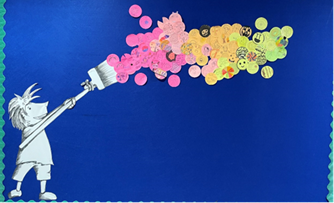
In EYFS children develop expressive arts and design as well as developing their imagination.
In Key Stage 1 children should be taught to use a range of materials creatively to design and make products and to drawing, painting and sculpture to develop and share their ideas, experiences and imagination.
In Key Stage 2 Pupils should be taught to develop their techniques, including their control and their use of materials, with creativity, experimentation and an increasing awareness of different kinds of art, craft and design.
Key documents:
PE
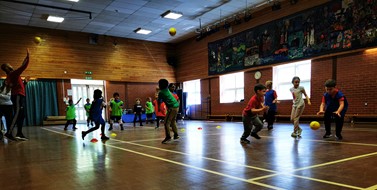
What is PE?
Physical education (P.E) is an educational process that uses physical activity to help pupils acquire knowledge, skills, fitness and attitudes that contribute to their optimal development and well-being.
Subject Intent
At Hollinswood Primary School & Nursery we aim to develop every child’s knowledge skills and attitudes for them to become effective learners. In physical education we provide an exciting, balanced and varied programme of activities and a range of sports that will contribute to each child's physical and emotional development. Through the teaching of physical education, we aim to promote our four key values, supporting each child to become more respectful, resourceful, resilient and responsible.
Our core aims – developed from the National Curriculum in England for PE- are for pupils to:
- develop competence to excel in a broad range of physical activities
- lead healthy, active lives
- be physically active for sustained periods of time
- engage in competitive sports and activities
The central component of our P.E. curriculum is the national curriculum, which is supported by Telford and Wrekin’s School Sports Partnership. We believe that our core values, are significantly enriched by a broad and balanced offer in our P.E. curriculum. We see P.E. as absolutely essential in developing their social, emotional and physical well-being. Furthermore, our curriculum encourages children to see the wider benefits of being physically active and healthy. Children are challenged to be responsible, resilient, respectful and resourceful when participating in P.E. lessons; playing competitive games inside and outside the classroom; partaking in our wide-reaching extra-curricular sports offer; representing our school at the many sports competitions offered throughout the school year; and being physically active when taking part in outdoor learning.
We strive to create a positive attitude towards P.E with correct teaching about the benefits of having a healthy lifestyle. We aim to encourage pupils to see the benefit of partaking in exercise beyond their time in education by fostering and encouraging a love of games, exercise and sport. The children are taught P.E. for 90 minutes a week by either their class teacher or by a specialist sports coach. During these sessions we aim to focus on pupils being active for 90% of the lesson, thus developing their fitness, stamina and ensuring they are active, while being taught key knowledge that is essential for them to develop their procedural and disciplinary knowledge.
We also encourage and develop the resilience of our pupils, by offering them opportunities to compete in games within P.E. lessons and when competing with schools in competitions organised by Telford and Wrekin School Sports Partnerships. This resilience, we believe is of benefit to them inside the classroom and when facing challenges outside of school.
Responsibility is another core aim of our offer in P.E. as children are expected to compete, while showing excellent sportsmanship whether they win or lose. Furthermore, our healthy eating initiative, PSHE curriculum, science curriculum and P.E. curriculum encourage children to know the benefits of a healthy lifestyle: ultimately, children are taught to be responsible for their own well-being through participation in sport, games and physical exercise.
During physical education lessons pupils have to be respectful, which is particularly challenging when we are encouraging pupils to develop their competitive spirit. Following principles in our behaviour policy, we have high expectations around children actively listening to instructions from coaches, teachers, and referees. This is emphasised in concepts and knowledge built in around respecting others and officials (see our MTPs). Listening to adults, while using equipment, ensures that pupils development in sport is nurtured in a safe, nurturing and encouraging environment. Consequently, our aim is for pupils to build respect for others, their peers and those in charge of safe guarding them, while taking appropriate risks.
Pupils are challenged to be resourceful in P.E. as we place a high value on substantive knowledge being used, talked about and embedded in children’s long term memories. Children, for example will learn and be expected to talk about how knowledge, body movements, feints and co-ordination are fundamental movements and or skills that are applicable across a range of sports. Children are expected to remember and know more, in order to develop their skills and do more; thus our value of being resourceful is also a core aim of our offer in physical education.
How the curriculum is designed
“There is no other subject that develops pupils such a broad range of pupils gross motor skills.”
In the Ofsted research review – motor competency- is considered the first pillar of progression in P.E. Wider theory on physical education underlines the importance of pupils being explicitly taught the fundamentals of movement (FOM), which the children are taught in every unit of work within P.E. Within this aspect of our P.E. curriculum, pupils are taught substantive knowledge and procedural (disciplinary knowledge) to enable them to develop their gross motor movements. To ensure that pupils are always developing this essential knowledge and attaching it to new sports, concepts and situations, every unit of work and every lesson focusses in on the fundamentals of movement. This is the central and core component to what and how pupils are taught in P.E.
Moving on from this, pupils are taught conceptual knowledge to support their development of fundamental skills, which can be applied to individual sports, but are mostly applicable across all sports played and taught. These fundamental movement skills, have a basis in substantive and then procedural knowledge that the children are taught. Examples of these would be coordination skills such as throwing, catching (manipulation), running, jumping (locomotor skills) balancing, twisting and moving to patterns (stability and balance skills). These concepts for P.E. can be found in the progression documents and MTPs attached below.
Another aspect of progression and what the pupils are taught is around the application of rules, strategies and tactics to games and sports. All previous knowledge and skills regarding fundamentals of movement and fundamental skills is still taught progressively; however, as they move through school children are taught to apply this knowledge and the skills to games and sports. To ensure this is done effectively, they are given knowledge about rules, tactics and strategies, which are all concepts in the P.E. progression and MTP documents.
Finally, the last aspect of progression, which is mapped through our emphasis on 90% activity during P.E. lessons, is around healthy participation. Linking back to our values, this idea of sport and well-being is encouraged through teaching children the benefits of being active. Abstract knowledge about sport being ‘good’ for you, is something pupils can often talk about; however, we teach pupils knowledge about exactly how your body and mind benefits from exercise. We are involved in a healthy lifestyle initiative, which supports pupils being active in opportunities within the community. This concept of healthy lifestyles is taught across PSHE, design and technology, science and in our P.E. curriculum.
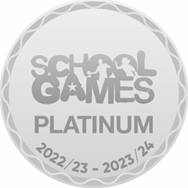
Finally, the last aspect of progression, which is mapped through our emphasis on 90% activity during P.E. lessons, is around healthy participation. Linking back to our values, this idea of sport and well-being is encouraged through teaching children the benefits of being active. Abstract knowledge about sport being ‘good’ for you, is something pupils can often talk about; however, we teach pupils knowledge about exactly how your body and mind benefits from exercise. We are involved in a healthy lifestyle initiative, which supports pupils being active in opportunities within the community. This concept of healthy lifestyles is taught across PSHE, design and technology, science and in our P.E. curriculum.
Healthy participation is also enriched by our participation in game. At Hollinswood Primary School and Nursery, we are proud to have been awarded the platinum games mark. The School Games Mark is a Government-led award scheme launched in 2012, facilitated by the Youth Sport Trust to reward schools for their commitment to the development of competition across their school and into the community, and we are delighted to have been recognised for our success. Our pupils voice supports our intent to increase healthy participation of pupils and many of the pupils said that because of sports and activities school has provided, they have taken up that sport outside of school and local clubs. This is very much the case with Gymnastics, Football, Tag Rugby and Cricket and the school has very good links with these external clubs as they come into school to do engagement days. Above our curriculum provision we have also enjoyed hosting sporting events at the school for local primary schools and schools further afield. We currently host football fixtures for the TWSSP event which involves many local primary schools and gives opportunities to try a number of sports from cycling to dodgeball and rounders. Its a great opportunity to engage all pupils and allow chances to try new sports and activities.
Our pupils have also taken part in multi skills events. Within these events, we involve students in the practical side of things but also in leading, scoring, assisting in umpiring and communicating tactics and knowledge with peers. This aids confidence, independence and increased knowledge and understanding.
With a total of young people competing in local inter-school competitions this year, we are extremely proud of our pupils for their dedication to all aspects of school sport, including those young volunteers, leaders and officials who made our competitions possible. As part of our application, we were asked to fulfil criteria in the areas of participation, competition, workforce and clubs, and we are pleased that the hard work of everyone at our school has been rewarded this year.
EYFS
In EYFS, pupils focus on developing the fundamentals of movement (FOM), with particular focus on exploring a variety of ways on how to move your body in a controlled manner. On the basis of developing basic motor competency the children are taught through multi-skills, which focusses on developing their fundamentals of movement, while building towards developing their fundamental movement skills which are manipulation, locomotor skills and stability and balance skills. This progression ensure that all pupils meet their early learning goal around the milestone markers from the EYFS framework:
- negotiate space and obstacles safely, with consideration for themselves and others.
- demonstrate strength, balance and coordination when playing.
- to move energetically, such as running, jumping, dancing, hopping, skipping and climbing.
KS2
In Key Stage 2, pupils develop and refine their fundamentals of movement (FOM) and fundamental movement knowledge and skills and apply them to a variety of games and sports such as football, hockey, rounders, gymnastics etc. Sports competition also starts to be introduced so pupils begin to develop tactical and teamwork skills. As they progress through school and across an individual year group we still focus on ensuring children overlearn, practice and apply their fundamentals of movement and fundamental skills, while gradually increasing the complexity to game situations.
Based upon these principles our curriculum is founded on teaching knowledge, both substantive and procedural in these four key principles- with the first (FOM) being the core element of our curriculum offer:
- The fundamentals of movement
- The fundamental skills (sometimes game specific)
- The rules, tactics and strategies known by pupils
- The knowledge pupils have around healthy participation
Therefore, lessons are structured as follows:
Warm up (FOM which is linked to the fundamental skill) - Learning objective shared based on knowledge needed and skill activity (modelled with success criteria shared) -Game activity - Cool down
Assessment
Each pupil is assessed based on the pillars of progression within P.E. which are the fundamentals of movement (balance, co-ordination and agility); fundamental skills which are (sending and receiving; locomotion and space); healthy participation; attacking, defending and rules. Each statement for each of these key areas is based on statements from the medium-term plans and progresses throughout each year group. We aim to ensure that all pupils have secure fundamentals of movement; therefore, if pupils are assessed as working below age related expectations, then interventions will be put in place to ensure pupils gross motor skills (FOM) are secure. Pupils are also spoken to and given specific targets that they need to work on based on these assessments.
Key documents
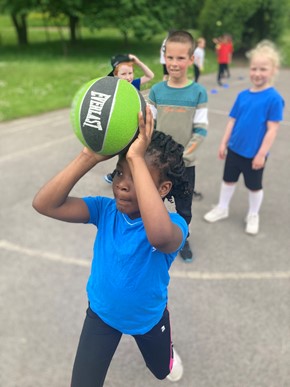
PSHE

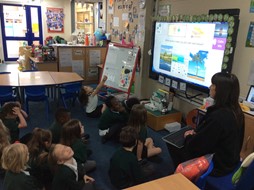
What is PSHE?
Relationships Education teaches the fundamental building blocks of positive relationships, focusing on friendships, family relationships, and relationships with other peers and adults. Health Education teaches us the information we need to make good decisions about our own health and wellbeing, to recognise issues in ourselves and others, and to seek support as early as possible when issues arise.
Subject Intent for PSHE
At Hollinswood Primary School & Nursery, we aim to develop every child’s skills, knowledge and attitudes in order for them to become responsible, resilient, resourceful and respectful learners.
Pupils are encouraged to be responsible members of the school, the local and the wider community. They are taught about celebrating differences, understanding their self-worth and how important it is to develop positive relationships. The children demonstrate responsible behaviour in sessions through productive debate and adherence of an agreed class charter.
Through a context rich curriculum that goes beyond the school walls, pupils are encouraged to have high expectations for themselves and are given the confidence to aim high. When faced with a problem, pupils are encouraged to be resilient and resourceful and to be passionate in overcoming obstacles.
We see excellence in teaching and a love of learning as a key to succeeding in life. In a supportive, positive and caring environment, pupils are encouraged to develop self-respect and be respectful of the ideas, attitudes, values and feelings of others regardless of race and culture.
This also supports the 'Personal Development' and 'Behaviour and Attitude' aspects required under the Ofsted Inspection Framework, as well as significantly contributing to the school's safeguarding and equality duties, the Government's British Values agenda and SMSC (Spiritual, Moral, Cultural) development opportunities provided for our children.
How the curriculum is designed
In EYFS, the children begin working on recognising and managing their feelings and look at how to face challenges. They begin to learn about how similarities and differences are celebrated and are introduced to the key relationships in their lives.
In Key Stage 1, children talk about rights and responsibilities; how to work collaboratively, how to listen to each other and how to make their classroom a safe and fair place. They learn about similarities and differences and that it is OK for friends to have differences without it affecting their friendship. Children discuss perseverance when they find things difficult as well as recognising their strengths as a learner. They talk about making healthy choices and learn about how family relationships widens to include roles and responsibilities in a family and the importance of co-operation, appreciation and trust.
In Key Stage 2, children talk about their own behaviour and how their choices can result in rewards and consequences. They learn about differences and similarities and that for some people, being different is hard. The children talk about their own strengths, further stretching themselves by setting challenging and realistic goals and they discuss the learning steps they’ll need to take as well as talking about how to stay motivated. They discuss taking responsibility for their own physical and emotional health and the choices linked to this and learn about the importance of self-esteem and ways this can be boosted.
RSE
We include the statutory Relationships and Health Education within our whole-school PSHE Programme.
To ensure progression and a spiral curriculum, we use Jigsaw, the mindful approach to PSHE, as our chosen teaching and learning programme and tailor it to your children’s needs. The mapping document: Jigsaw 3-11 and statutory Relationships and Health Education, shows exactly how Jigsaw and therefore our school, meets the statutory Relationships and Health Education requirements.
Key documents
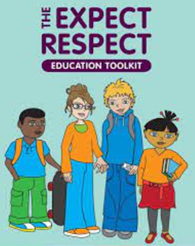 |
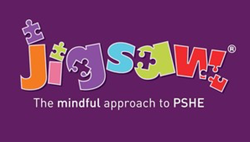 |
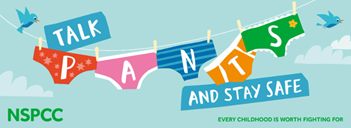 |
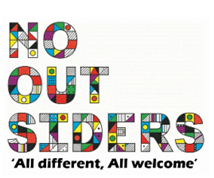 |
Modern Foreign Languages – Spanish
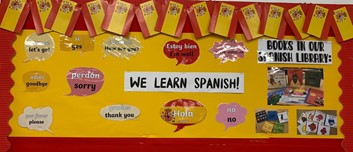

What is Spanish?
Language learning is developing the ability to communicate with others. Learning a foreign language provides an opening to other cultures. It is the expression of ideas and thoughts in another language. It consists of four key skills: reading, writing, speaking, and listening.
Subject Intent for Spanish
Spanish equips pupils with the knowledge, skills and confidence to understand and communicate with different communities and cultures from around the world.
At Hollinswood Primary School & Nursery, we aim to develop every child’s skills, knowledge and attitudes in order for them to become responsible, resilient, resourceful and respectful learners.
In Spanish, pupils show they are responsible learners by having high expectations of their own work and extending their learning by accessing questions that embed this learning.
To be resourceful, children are encouraged to use resources that are in their classroom environment to support them with their learning. These include Learning walls, Class Spanish Dictionary and their floor book to access previous lessons learning.
Being resilient is an important part of learning a foreign language. Pupils are encouraged to bring a ‘Have a go’ attitude to every lesson by exploring pronunciation and intonation of new and unfamiliar words and phrases. This supports EAL pupils by removing any language barrier and creating a level playing field for all pupils.
Spanish naturally lends itself to allowing children to become respectful learners. Within lessons, pupils are exposed to different cultures and beliefs that are different to their own. They are encouraged to be inquisitive and ask appropriate questions to develop and deepen their understanding of these cultures and beliefs.
How the curriculum is designed
Through a knowledge rich curriculum, students will acquire the skills needed to develop the four main skills of reading, writing, speaking and listening. Each topic children will apply the knowledge they are taught to each of these skills. All pupils should leave Hollinswood primary school with a good solid foundation in the Spanish language. This will equip them to start secondary school languages with sound knowledge of any language they will learn. Pupils shouldn’t just encounter knowledge, but to remember it. The curriculum is designed in a way to support this. With children learning key knowledge and repeating these in more depth each year. For example, in year three children repeat and recognise some of the numbers 1-10 in Spanish and can count from 1-10 in Spanish with a scaffold and by year 6 they will be able to read and solve maths problems that use numbers 1 -20 in Spanish. Children will learn that Spanish is more than just a language, it is a culture. Children will leave Hollinswood knowing where Spain is, it's cultures and traditions and how Spanish culture has had an impact on the wider world.
Key documents
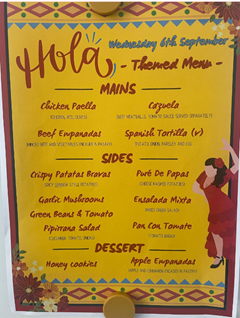 |
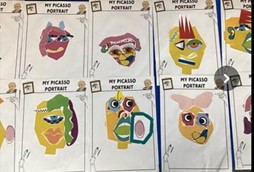 |
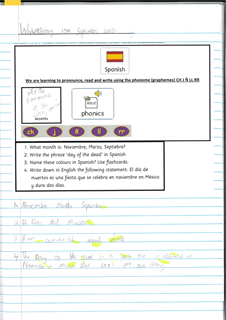 |
Religious Education
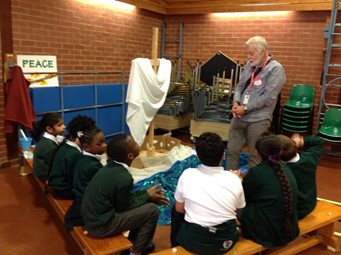
What is RE?
RE is a way for children to acquire core knowledge and understanding of the beliefs and practices of the religions and worldviews, which not only shape their history and culture, but which guide their own development. The modern world needs resilient and resourceful young people who are sufficiently confident in their own beliefs and values that they can respect the religious and cultural differences of others and contribute to a cohesive and compassionate society.
‘All children need to acquire core knowledge and understanding of the beliefs and practices of the religions and worldviews which not only shape their history and culture but which guide their own development. The modern world needs young people who are sufficiently confident in their own beliefs and values that they can respect the religious and cultural differences of others and contribute to a cohesive and compassionate society.’ from NATRE (National Association of Teachers of Religious Education).
Subject Intent for RE
Through the teaching of RE we aim to instil our four values enabling children to become responsible, resilient, resourceful and respectful learners.
Our RE syllabus encompasses the major faiths reflected in Britain today especially those that reflect the demographic of our local school community.
We aim to give every child a deep understanding of Religion to help them become respectful of the religious beliefs of others in a diverse society.
We teach our children how to be resourceful learners by learning about religion in different ways: from visits to places of worship, first-hand experiences from visitors to school during assemblies and in class, by studying artefacts and research from religious texts and multisensory research opportunities.
Learning from religion can help each child become responsible citizens. By studying religious stories and experiences, we can help children learn how faith teaches us to be resilient in the face of adversity.
Above all we aim to make Religious Education meaningful for all children and equip them with the knowledge and skills that to become informed, respectful members of society who celebrate diversity and strive to understand others.
At Hollinswood we endeavour to make Religious Education engaging and with a real – life context through visits, workshops, artefacts and assemblies.
How is the curriculum designed?
At Hollinswood Primary School & Nursery, we teach Religious Education following the Telford & Wrekin locally agreed syllabus guidelines accompanied by the Jigsaw RE Scheme of learning. The curriculum map shows exactly how Jigsaw and our school, meets the statutory requirements for the teaching of RE.
Breadth of Study.
It is expected that Primary Schools ensure that Christianity is included across all year groups. At Hollinswood, we focus on the main world religions as follows: EYFS: Christianity (including stories from other world religions). Key Stage 1: Christianity, Islam, Sanatana Dharma (Hinduism), Judaism; Key Stage 2: Christianity, Islam, Sanatana Dharma (Hinduism), Judaism.
What are Pupils taught in RE?
‘We are proud to teach inclusive and plural RE, following the local Agreed Syllabus, to all our pupils, and to respect and affirm all the religions and worldviews represented in our community. We are happy to talk to parents about RE. We do not support selective withdrawals from RE’. (T&W Agreed Syllabus 2021)
As the children move through year groups, their learning about Religion and learning from Religion follow a set progression of skills and knowledge.
Our scheme of work and agreed syllabus can be found by following the links below.
Collective Worship
Collective worship (assemblies) represents a powerful way to develop and establish a school’s ethos and values. Schools have a duty to provide collective worship to promote Spritual, Moral and Cultural development. Our assemblies combine opportunities to explore RE, PHSE and other curriculum areas, as well as share news and updates from School groups such as Eco Club, Safe Guarding Squad and the School Council.
The Right to Withdrawal.
We are proud to teach inclusive and plural RE, following the local Agreed Syllabus, to all our pupils, and to respect and affirm all the religions and worldviews represented in our community. RE is an important part of our inclusive school curriculum and as such we do not support selective withdrawals from RE. We are happy to talk to parents about all aspects of the RE curriculum and discuss any concerns. The Head Teacher and Governing Body are responsible for seeing that the law on Religious Education is complied with in school and therefore any applications for the withdrawal of children from the RE curriculum should be submitted to the headteacher in writing.
Key documents
Telford and Wrekin Agreed SACRE Syllabus
|
l |
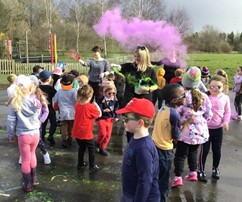 |
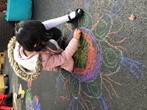 |
Science
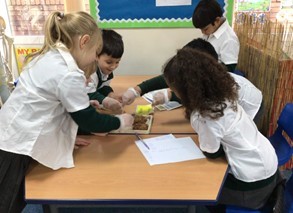
What is science?
Science allows pupils to develop an understanding of the nature, processes and methods of Science through different types of Scientific enquiries that helps them to answer scientific questions about the world around them.
Subject Intent for Science
At Hollinswood Primary School & Nursery, we aim to develop every child’s skills, knowledge and attitudes in order for them to become responsible, resilient, resourceful and respectful learners.
In Science, pupils are encouraged to be responsible members of the school, the local and the wider community. They are taught about the environment and how to be responsible in caring for the environment.
Through a context rich curriculum that goes beyond the school walls, pupils are encouraged to have high expectations for themselves and are given the confidence to aim high. When faced with a problem, pupils are encouraged to be resilient and resourceful, to be passionate in overcoming obstacles and alive for a challenge.
We see excellence in teaching and a love of learning as a key to succeeding in life. In a supportive, positive and caring environment, pupils are encouraged to develop self-respect and be respectful of the ideas, attitudes, values and feelings of others regardless of race and culture.
How the curriculum is designed
The Curriculum has been developed to ensure that children are being taught the substantive knowledge of Biology, Chemistry and Physics (knowledge of the concepts of science, theories, concepts laws and models) whilst concurrently being taught the disciplinary knowledge of science (working scientifically).
The curriculum has been organised around key scientific concepts which children are taught progressively, in small steps, and which they integrate with knowledge that they already have from previous years. Complex concepts and procedures are broken down into meaningful chunks of content which are sequenced in the curriculum over time.
Pupils learn a body of knowledge relating to the products and practices of science. They are able to explain the material world and develop a sense of excitement and curiosity about the natural environment. They learn how scientific knowledge becomes established through scientific enquiry and appreciate the nature and status of scientific knowledge. Pupils will also learn about the continuing importance of science in solving global challenges.
We aim:
To develop pupils’ interest in and enjoyment of science
To enable pupils to effectively communicate scientific ideas through the use of scientific vocabulary.
To develop scientific knowledge and a conceptual understanding of science through enquiry based experience of chemistry, biology and physics. The key concepts are working scientifically, materials, energy, solar system, life and growth and human processes.
To develop positive attitudes which encourage collaborative learning and perseverance.
To develop understanding of the nature, processes and methods of science through different types of scientific enquiry that help pupils to explore the world around them.
Key documents
Whole school curriculum yearly overview
Forest School and Outdoor Learning Roadmap
Geography, Science and D+T Roadmap



